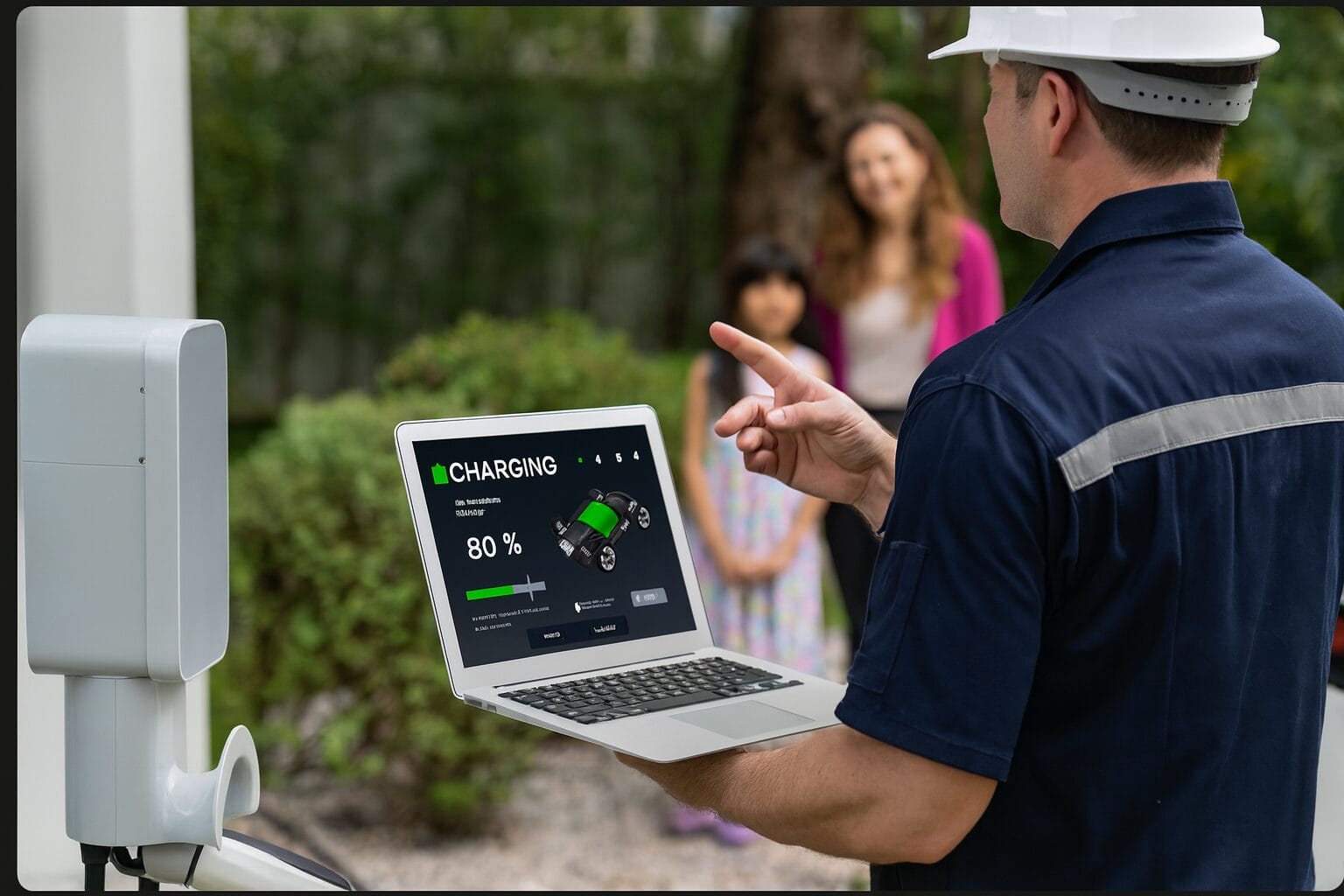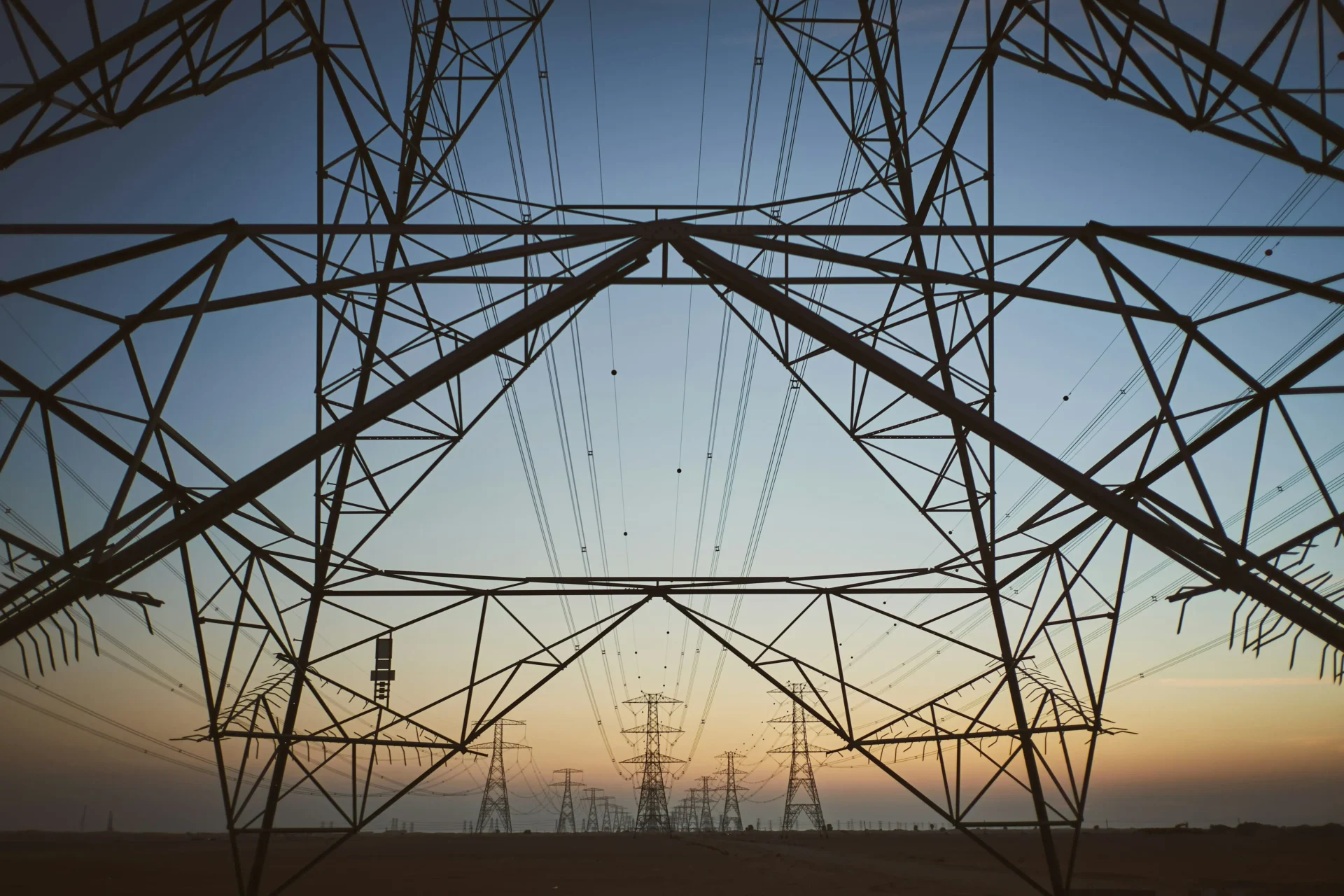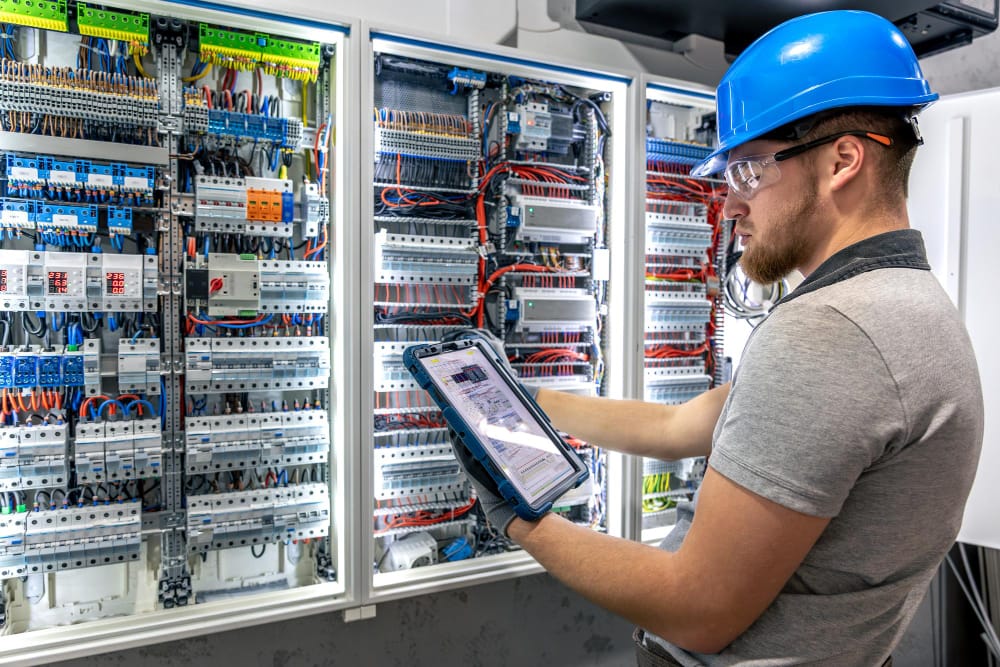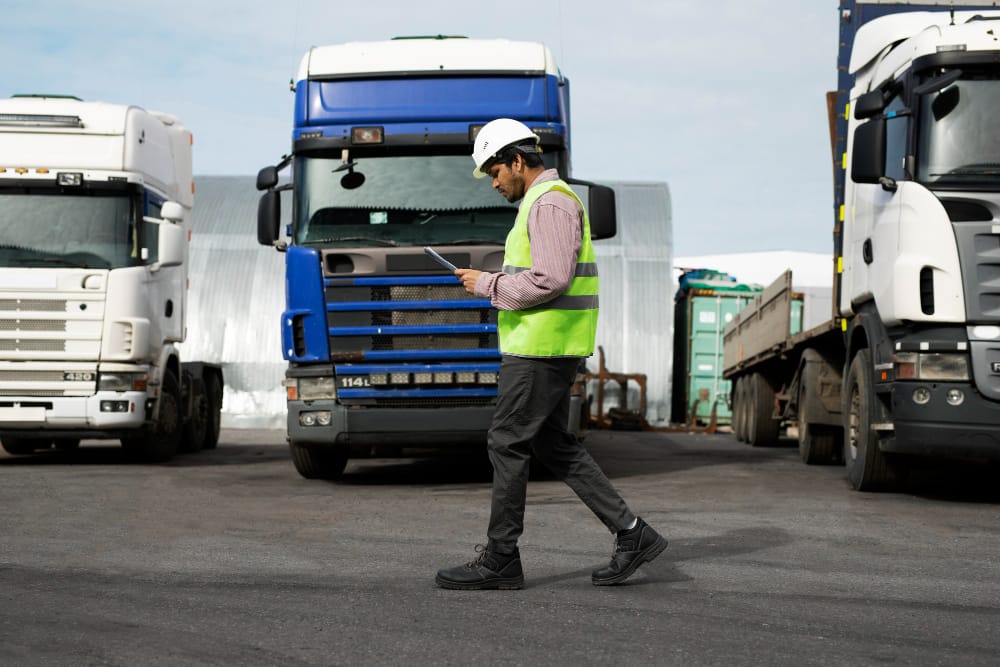Agriculture is a fairly fast-paced industry, businesses in which tend to adopt recent technology advancements rapidly. One of the recent improvements is IoT precision farming, which promises enhanced productivity and better worker safety.
In this post, you’ll discover the state of the precision farming market in 2025, as well as the benefits and applications of IoT in agriculture. Besides, you’ll explore how smart agriculture works and find out how to get started with your precision farming using IoT projects.
Precision farming market in 2025
Precision farming is an advanced agricultural approach that leverages IoT, AI, and data analytics to optimize resource use and improve crop yields. IoT in precision agriculture enables farmers to collect real-time data on soil conditions, weather, and crop health through sensors and drones.
It’s interesting to take a look at the state of precision farming and IoT in the agriculture market as of 2025. Relevant statistics and facts are provided in the infographics below:
As you can conclude, stats indicate significant growth potential for IoT applications in agriculture. So, we can only recommend starting to adopt this advanced technology. Here at Intelliarts, we have been combining IoT with agriculture applications for years already, delivering enhanced business outcomes. The very success stories are detailed further in the text.
You may be interested in exploring data science in business for a more complete picture of how smarter tech is used across domains.
What are the benefits of IoT in the field of agriculture?
The time is just right to delve into the actual benefits that IoT in agriculture can bring. To provide the complete picture, we gathered all the possible benefits, both related and slightly distant to precision farming, and linked them to the corresponding usage. The list is as follows:
- Cost reduction through automated resource management
- Improved yield via real-time crop monitoring and precision farming
- Sustainable water usage with smart irrigation systems
- Reduced pesticide use with targeted pest control solutions
- Enhanced soil health via IoT-based nutrient monitoring
- Predictive analytics for better crop planning and risk management
- Automated farm operations reducing labor costs
- Supply chain optimization with real-time logistics tracking
- Better livestock management through smart wearables and health tracking
- Climate resilience via AI-driven weather predictions
- Energy efficiency in farm equipment with IoT-based power management
- Waste reduction through smart storage and inventory monitoring
- Remote farm management enabling control from any location
- Real-time alerts for disease detection and prevention
- Improved decision-making with AI-driven data insights
- Increased food security by optimizing agricultural production
- Smart greenhouse automation for better environmental control
- Faster issue detection reducing crop losses and inefficiencies
As you can see, AI and IoT can offer a lot of useful technology implementations. The real question here is how to prioritize one over the other and how to get started. Hopefully, the following sections will guide you through.
Discover additionally about the use of IoT in smart grid technology as lots of technology applications in this niche and agriculture intersect.
How smart agriculture works using IoT?
To keep the answer focused, we’ll use the example of soil monitoring and follow the steps of how smart agriculture and precision farming using IoT works:
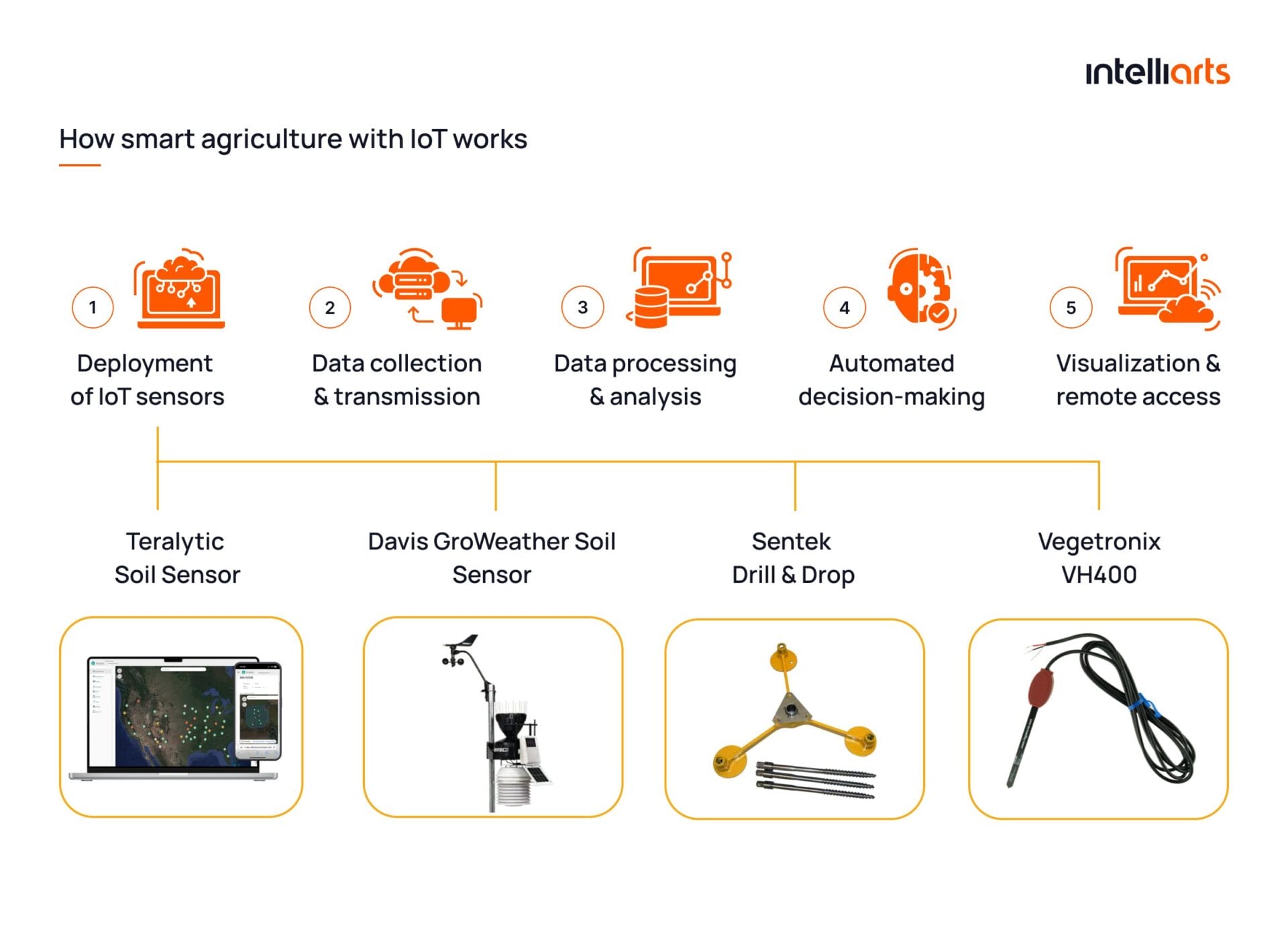
#1 Deployment of IoT sensors
Farmers place wireless soil sensors across the fields. Here are some of such sensors available on the market:
These sensors measure parameters like moisture levels, temperature, salinity, pH, and nutrient content in real-time.
#2 Data collection & transmission
The sensors continuously collect data and send it via Wi-Fi, LoRa, or cellular networks to a central cloud-based platform.
Explore big data collection and transmission in another blog post by Intelliarts.
#3 Data processing & analysis
The cloud platform uses AI and analytics to interpret soil conditions, identifying areas that need watering, fertilization, or drainage improvements.
#4 Automated decision-making
Based on the analysis, the system can automatically trigger irrigation systems or send alerts to farmers for necessary interventions.
#5 Visualization & remote access
Farmers monitor real-time soil conditions through a mobile app or web dashboard, allowing them to make informed decisions without the need to be physically present in the field.
Other similar use cases can be many. For example, with the application of computer vision, a business can watch over the crop’s health, using visual characteristics like color or integrity of leaves. Implementing such a system would merely require swapping sensors for cameras, with other steps in the provided flow left the same.
Success story: Redesigning Indigo Ag’s legacy system for land sampling
Here we’d love to bring a success story by Intelliarts as an example of an effective usage of IoT technology to solve a business challenge in agriculture — Redesigning Indigo Ag’s legacy system for land sampling to reduce manual tasks and enable seamless data automation.

Challenge:
Indigo Ag’s legacy land sampling system relied on manual processes, causing inefficiencies in data collection, delays in lab submissions, and errors in sample tracking. The company needed an automated solution to improve workflow efficiency and ensure accurate, real-time data availability.
Solution:
Intelliarts redesigned the system by integrating IoT sensors, QR codes, and mobile applications for seamless automation. The new agriculture software development system digitized sample tracking, automated data collection, and streamlined lab submissions enhancing data accuracy and accessibility.
Results:
The solution reduced manual tasks, cutting errors, and processing delays. Automated sample tracking improved efficiency, while the sensor inventory system lowered losses to fewer than 4 per 1,000. The centralized approach enabled real-time data analysis, accelerating decision-making and enhancing overall productivity in Indigo Ag’s land sampling operations.
Challenges & solutions in implementing IoT in precision farming
Naturally, decision makers may expect their projects to face common challenges and issues related to implementing advanced tech in conventional farming processes. Here, it’s essential to be well-prepared so it would be possible for your businesses to respond to risks immediately or, even better, minimize them in advance. The list of challenges and solutions is as follows:
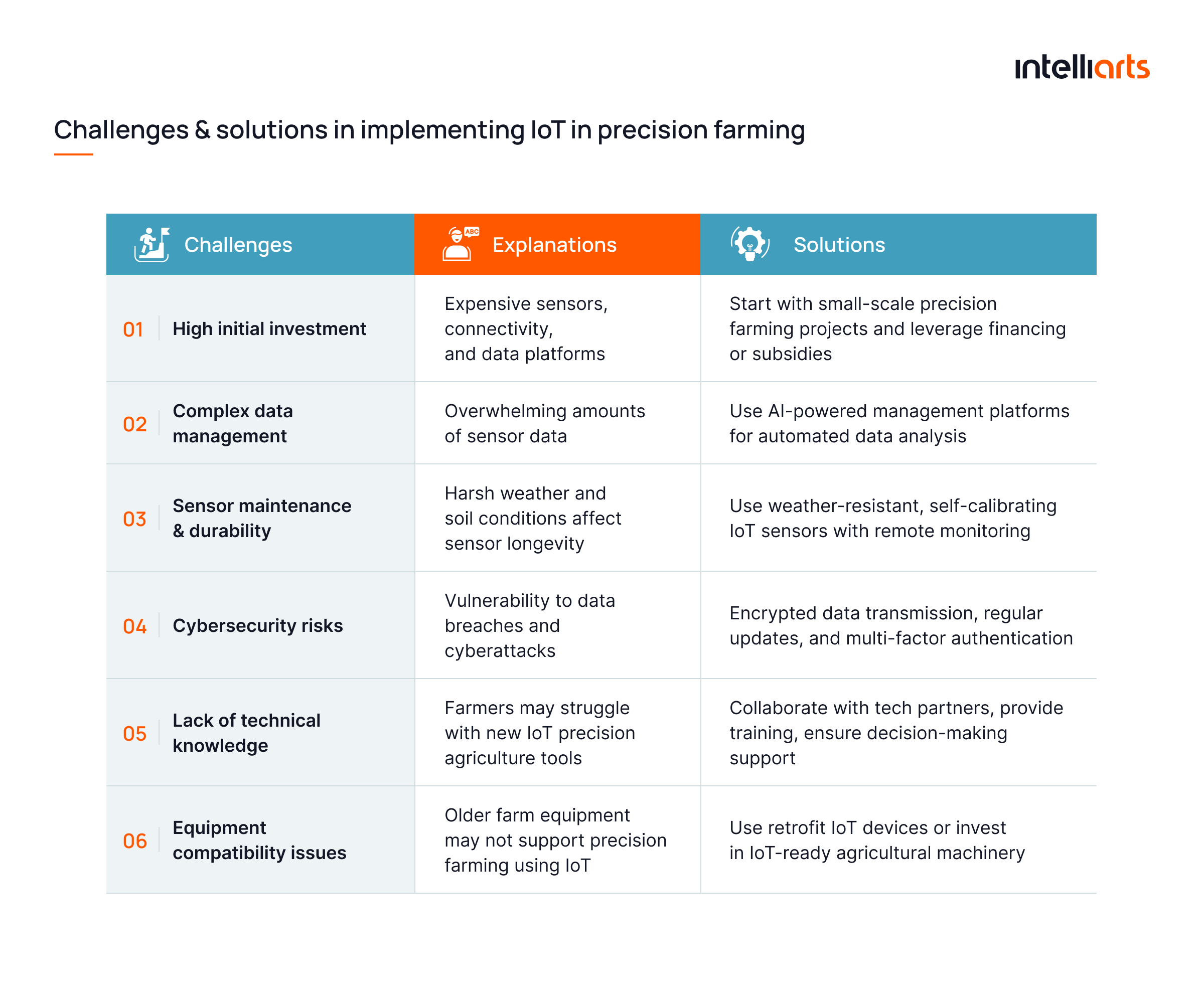
Retrieval and usage of data has always been a sensitive issue for non-tech businesses. AS the data automation project for Indigo reveals, it’s possible to eliminate the least efficient processes and enhance decision-making for an agricultural company. — Alexander Barinov, Managing Partner at Intelliarts.
Explore case studies by Intelliarts to find out how we address challenges with IoT in agriculture and related niches.
How to get started with IoT in precision farming
To be honest, there’s no simple answer to the question of how your particular business should get started with IoT in precision agriculture. However, given the above-mentioned considerations, possible applications, and challenges, this is how I suggest approaching this matter:
#1 Compare your readiness and available resources against your objectives
In IoT and precision farming, you will likely start your project with just a bunch of sensors and a diverse in-house team. Evaluate the following:
- Labor resource availability
- Allocated budget
- Technological feasibility
- Digital and physical IT infrastructure
- The scope of work
- Implementation timelines
Most likely, this alone would provide you with a rough estimate of your capabilities and needs. For example, you may find out that you lack workers available to work as operators, managers, engineers, etc. You may detect the impossibility of developing your own IoT infrastructure, leaving you with only cloud solutions to choose from, etc.
#2 Find a trusted technology partner
Having the right software provider is half the battle. Without further ado, here are aspects that tech partner covers in precision farming using IoT projects:
- Assistance with choosing the right sensors, software, and cloud providers
- Consultancy on budget, labor resources, timelines, and other constraints
- Recommendations on how to place sensors
- Development and deployment of a unified IoT system
- Development and deployment of big data and analytics software solutions
- In-house team training
As you can see, providers cover most of the development scope, leaving you only business aspects to handle, as described below.
For instance, here, at Intelliarts, a software development agency, we have delivered more than a dozen of IoT and agriculture projects, offering smaller developments as well as end-to-end implementations. Therefore, we are well aware of what your business may potentially need to reach its objectives for the projects, so we can provide both consultancy and execution.
#3 Implement the development of IoT in precision farming
Here the role of the business owners boils down to high-level management. Given that your trusted tech partner can help with all the above-mentioned, you have the following processes to cover:
- Project progress monitoring
- Clarifying business objectives
- Budgeting
- Synchronizing with your vendor’s representatives
- Keeping stakeholders informed
- Connecting tech vendors with your in-house teams and third-parties
#4 Recruit the in-house team
As mentioned, human resources are required for an actual IoT in precision agriculture implementation. Sticking to the same example of soil monitoring, you may need the following specialists:
- Agronomist or soil scientist
- Farm operations manager
- Field technician
- Data analyst
Plus, given that soil monitoring is only one agriculture aspect, other employees may need to be trained on using, for example, reports obtained via the IoT software solution.
#5 Launch and monitor
All that’s left is to let your tech partner deploy the solution and ensure that it operates as expected. While waiting for data and reports, you need to plan for one or other actions to execute, based on reports’ date.
The end result of the project is to have a semi-automated soil monitoring system that is IoT-driven, have instructions for employees on how to act, and have a complete, fully trained team. Ensuring this will lead to fulfilling the business objective you set with this project.
Future of precision farming with IoT and beyond
Given the high rate at which smart tech and precision farming develop, it’s possible to forecast several trends for the niche:
- 5G-enabled smart farming networks. The adoption of 5G will enhance precision farming using IoT, allowing ultra-fast data transmission, real-time analytics, and seamless connectivity for remote farm monitoring.
- Blockchain for agri-supply chain transparency. IoT in precision agriculture will work with blockchain to track crop origins, quality, and environmental impact, ensuring transparent, tamper-proof records from farm to market.
- Climate-adaptive farming with IoT & AI. Advanced AI models combined with IoT precision agriculture will analyze climate patterns, soil health, and water availability, enabling farms to adapt to extreme weather and resource constraints.
- Digital twin technology for farm simulation. Precision farming with IoT will leverage digital twins — virtual farm models using real-time sensor data — to simulate scenarios, predict outcomes, and improve decision-making.
Explore how digital twin technology works and use cases in another blog post by Intelliarts.
While the mentioned may seem like a little too extreme for trends, or something that stands a chance to be utilized only sparingly, that may not be the case. Since AI evolution, which drives such technological progress, is nearly in its golden era, businesses that strive to become top players in the market, will likely utilize all the recent advancements, resulting in accelerated technology adoption across the globe.
Final take
Precision farming with IoT is reshaping agriculture, offering data-driven efficiency, sustainability, and cost reduction. Successful implementation requires strategic planning, the right technology partner, and a skilled team. As IoT adoption grows, innovations like 5G, blockchain, and AI-driven climate adaptation will drive the next wave of smart farming. Businesses that embrace these advancements will lead the future of sustainable, high-yield agriculture.
Any successful project has a technical team behind it. Should you need consulting or an execution of your idea end-to-end, don’t hesitate to reach out to Intelliarts. With more than 24 years of experience and with 90+ of projects, including ones in IoT and agriculture niches, we can provide you with the necessary software development and more.
FAQ
1. How is smart farming used in IoT?
Smart farming uses IoT to collect real-time data from sensors on soil moisture, weather, and crop health. This data enables precision farming using IoT, optimizing irrigation, fertilization, and pest control. Automated systems adjust inputs based on sensor data, reducing waste and improving yields.
2. What is the role of AI and IoT in sustainable development in agriculture?
AI and IoT in precision agriculture enable efficient resource management by analyzing data from IoT sensors. AI predicts crop diseases and optimizes water and fertilizer use, minimizing waste. This approach supports sustainable agriculture by reducing chemical runoff and conserving water.
3. What are the biggest costs in farming?
Labor, equipment, and input costs like seeds, fertilizers, and pesticides are the biggest expenses. Energy costs for irrigation and storage also contribute significantly. Precision farming with IoT helps reduce these costs by optimizing resource use and minimizing waste.






